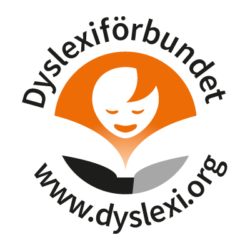
Patience Thomson vid MA.Cantab MEd.Bangor ger här sin syn på hur text kan presenteras för att bli tillgänglig.
Engelsk text. Kan omvandlas med översättaren. A new approach Five years ago I co-founded a publishing house, Barrington Stoke. I wanted to produce really gripping fiction for reluctant readers of all ages who were just fluent enough to read ”real” books, but found the easier ones written for younger children too patronising and the age-appropriate ones too daunting.
Kind friends pointed out that this seemed an unrealistic and foolhardy project, because reluctant readers do not of course buy books. But throughout a long teaching career I had always felt passionately that less able readers were often short-changed and patronised in what they were offered. I wanted to try a new approach.
Reluctant readers as editors and consultants
We would commission original stories from the first class, famous authors who were popular with the competent readers too. I would get the reluctant readers themselves to edit the manuscripts. This seemed to some a curious idea. A famous author once said to me, ”Children have not enough literary experience to act as serious critics.” She was talking of course about children who are competent readers. I imagine if I had told her I was using less able readers in an editorial capacity she would have thought I was crazy. And yet I have discovered that once you get them going, less competent readers, perhaps because they read more slowly and carefully, make astonishingly good critics.
The editorial process – the consultants’ role
When our selected consultants edited a book they looked at every aspect in their appraisal. They were unexpectedly thorough! Some have even included the page with the copyright details, which they suggested should be omitted. When told that legally they had to be there, they asked us to write in mock hand-writing across the page YOU DO NOT NEED TO READ THIS PAGE, JUST GET ON WITH THE BOOK, which we did. In the same way they asked for interesting details about the authors and illustrators, what music, children’s names and food they preferred, not where they lived or how many children they had. Then they turned their attention to the ”blurb” on the back. Make it a question, they demanded. ”Are your parents normal?” ”Have you ever fancied anyone from afar?” ”Have you ever told a fib because it was easier than the truth?” The answer would be in the book. If the title of the book was dull or gave too much away, they suggested we change it! These consultants edited the manuscripts line by line and word by word. They determined which words were hard to read, reported anything that confused them in the text and sometimes made their own suggestions for alternatives. Lest this should seem too negative an activity, they were also asked to check out the conversation in the books to make sure the language was genuinely that of the street and the playground and not what adults imagined children might say. ”A.1. at football!” No-one would say that!
The editorial process – my role
The consultants comments were then collated and rationalised by a Speech and Language Therapist before I did my final edit. This was because we wanted to assemble a database of the changes requested by the consultants and consider their implications in a broader linguistic context.
All the stories were aimed at readers with a reading age of 8+. It could hardly be expected that the well-known and popular authors whom we had enlisted to write for us would have either the expertise or inclination to change their style, vocabulary and language structure to suit readers with this lower reading age . My task would be to consider the comments made by our consultants and then to edit the text to make it easily accessible to all reluctant readers without losing the spirit of the original. And the authors were usually prepared to accept these changes if they were made in the light of the readers’ comments but if they had objections, their right of veto was absolute.
The editing had to be done with subtlety. This was to be literature not just prose. The rhythm of the language must be maintained, the stories must not lose pace, and the authentic voice and style of the individual author must remain clearly apparent. My job was to bear all this in mind whilst editing the text to make it easily accessible to the under-confident reader.
My concern at first was that there would be no consensus of opinion among our reluctant readers, for then consistent editing would have been impossible. In fact the children were almost unanimous in identifying the same snags and difficulties in the text. The only controversial area turned out to be the choice of illustrations. Individuals with the short-term memory problems commonly experienced by many poor readers often like to run a story in their heads like a video tape; their imagination will create its own descriptive detail and the illustrations may not be to their taste.
Patterns of difficulty
From the very beginning distinct patterns began to emerge which were reinforced and clarified as we extended our range of books.
Vocabulary
• The familiarity and specific meaning of a word matters more than its actual length.
• Concrete words are easier than abstract ones.
• Adverbs cause particular difficulty, whether long or short. ”Utterly” was as problematic as ”anxiously”. A phrase like ”oddly enough” completely defeats the less competent reader.
• The first few pages of the book are crucial and language must be crystal clear. As the readers gain confidence and get into the story they can cope with more challenging vocabulary.
• Surprisingly, puns are appreciated. But many figures of speech are taken literally and not understood. ”YUCK” they wrote in the margin when the hero ”pushed his glasses up his nose”.
• Conversation is generally easier to read and should be natural rather than grammatically correct, with ”it’s” for instance preferred to ”it is”.
Language Structure
This appears to be even more crucial than choice of vocabulary. It is not the length of the sentence, but the simplicity of the language structure that is the crucial element.
• The active tense is much easier than the passive.
• Gerunds and gerundives are confusing. ”Coming out of the lane he saw…”
• Modal verbs such as ”should” and ”might” are best kept to a minimum.
• Multiple phrases or clauses should be avoided.
• Ellipsis (as in ”that was that”) is hard, as readers with weak language skills find it difficult to make the necessary linkage to a previous reference.
Inversion, where the subsidiary clause comes first, should be used sparingly.
Comprehension
• Hesitant readers cannot cope with inference.
• The time sequence of the story must be clear and flashbacks handled with the greatest care.
• Allusions to well-known people, places or events are often lost on the poor reader. What is the CIA? Who are the Gestapo?
• People must be referred to consistently by the same name, pet names and nicknames only confuse. Presentation We extended the consultants’ role to include matters of presentation. The following facts emerged.
• Cream or yellow paper is preferred to white. A surprising number of poor readers are light-sensitive and modern fluorescent lighting and sunny classrooms can result in black print on white paper being particularly painful to the eye.
• Right-hand justification is unhelpful. It causes uneven spacing between words, which is confusing. Lines of differing length have more character and enable the hesitant reader to keep their place.
• Spacing between letters, words, sentences and paragraphs should be marginally wider than usual as this aids visual discrimination.
• Our field research revealed that within reason the choice of typeface was not so important as additional spacing between the individual letters. The ”rn” combination for instance, when set close together, was easily mistaken for an ”m” in several typefaces. However we went to great trouble to adapt a simple, clear, standard typeface for Barrington Stoke use, so that , for instance, the letters ”g” and ”a” reflected the shapes of the handwritten letters. This was more significant than the choice between serif and non-serif, where our research with the readers was inconclusive. Words entirely in capitals should be avoided, as they have no distinct shape and the letter combinations look unfamiliar. It should be remembered that if there are illustrations, they often contain text in different and sometimes elaborate fonts which are easily overlooked in the editorial monitoring process and may well need to be changed
• Small print is off-putting and hard to decipher. However larger than point 14 can prevent the reader from chunking the text for meaning, as too few words can be scanned in an eyeful.
• The cover of the book should look attractive and normal and not indicate that these are books especially designed for weak readers. There must be no hint of patronage.
Illustrations
• They give background information and explain difficult words which are essential to the story, e.g. barrage balloon. • They break up the text.
• They help the readers to recap on the story and to find their place.
• They should not wander over the text, as this is confusing.
• They should have a focal point, be easy to scan and have only relevant detail. Readers with poor visual perception may find it hard to extract essential information if the illustrations are too ”busy”.
Conclusions
Individually many of these points may be familiar. Consultation with colleagues from different disciplines (an orthoptist, a speech and language therapist, teachers and language specialists) have confirmed our findings. But since there are so many diverse causes of reading difficulties, a successful approach must address all the issues concurrently to ensure maximum success. Reluctant readers initially need books where all their problems have been identified and addressed if they are to gain the confidence which will enable them to graduate to more challenging reading material. So will reluctant readers buy and enjoy fiction if it is suitably adapted to their needs for a gripping story in an accessible form? Having sold almost a million books in our first five years we reckon they will.
Patience.Thomson@btinternet.com
Professional Profile Patience Thomson has 30 years experience of teaching children with reading difficulties. She was formerly Principal of Fairley House School, London. She writes articles in the Daily Telegraph and lectures widely in the UK and abroad. Patience Thomson is currently Chairman of Barrington Stoke, an award-winning company producing ”fast fiction” by first-class authors for reluctant readers.
For more details of the company contact: Barrington Stoke, 10 Bedford Terrace, Edinburgh EH4 3DQ Tel: 0131 315 493
Här hittar du artikeln i annat format
http://www.barringtonstoke.co.uk
(Språka loss 2002)

